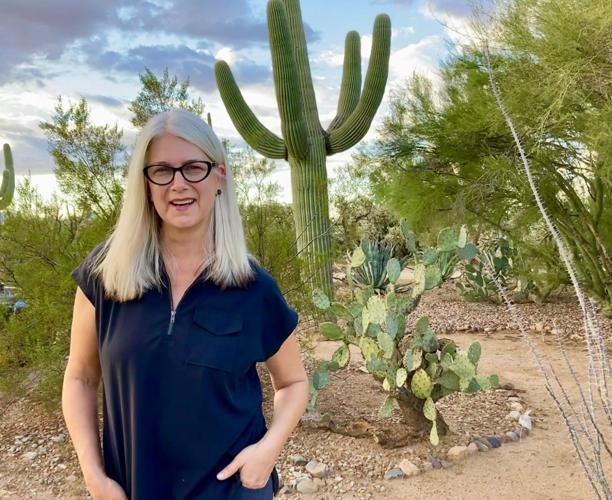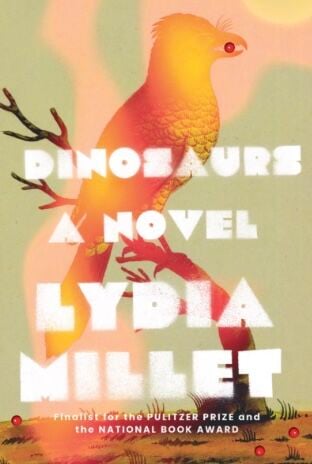To understand where Lydia Millet is coming from as a writer, it helps to see where she is coming from as she writes, which is the porch of a small house near her own in the Sonoran Desert west of Tucson.
Not near the desert, mind you. In it, in a small clearing surrounded by lush stands of palo verde, mesquite, cactus and creosote.
To find Millet this late afternoon, a visitor winds slowly down a narrow dirt road, carefully threading his way through cholla and prickly pear. A saguaro points the way past a parked sedan the owner has re-painted Forest Service green.
Some people find solace in soothing meadows surrounded by daffodils. Millet finds it here, which may explain the prickly edge to some of her recent books.
Her latest, “Dinosaurs,” was released last week by W.W. Norton & Co. It is her first novel since “A Children’s Bible,” a bestselling finalist for the National Book Award in 2020.
“Dinosaurs” is Millet’s 13th book, all of which have been warmly received and many of which have received national awards. “Love in Infant Monkeys” was a finalist for the Pulitzer Prize in 2010. “Sweet Lamb of Heaven” was a semifinalist for the National Book Award in 2016.
Eleven of her books were written since Millet moved to Tucson — and purchased 14 acres of desert real estate — in 1999.
“I just love it here, it’s my favorite place in the whole world,” Millet said of her arid Shangri-La. “When I first bought it, I was planning to live here part-time. I had a life and a boyfriend in New York City. I thought I’d be spending some of the year here and some of it there. After I moved in, though, I just loved it so much I stayed.”
Millet’s move to Arizona may have surprised some of her Manhattan neighbors. She was a city girl, raised in Toronto and educated at the University of North Carolina. Less well-known was the fact Millet had spent four months in the graduate writing program at the University of Arizona. Her mentor there was UA professor and National Book Award finalist Joy Williams. It was Williams who suggested Millet get to know her beloved desert.
It didn’t quite take at first, either the writing part or the desert part. Millet dropped out after a semester, and instead earned a master’s degree in Environmental Policy at Duke. She then accepted a position with the Natural Resource Defense Council in New York. Life was good, but something was missing.
She came looking for it in 1999, accepting a position as a writer for the Center for Biological Diversity in Tucson. She is still there. Her 30 hours a week at the center are framed by three to four hours of writing in the early morning and late afternoon.
“My mom doesn’t live there now, but she has a small house and some property right beside me,” Millet explained. “That’s where I usually write. I write outside whenever I can, even when it’s hot. It’s where I feel most comfortable.”
Who knows who might stop by to say hi. Deer, coyotes, foxes and javelinas are regular visitors to Millet’s outdoor writing studio. Birds play a starring role her new novel. She mentions a different bird in every chapter, and sprinkles in scientific tidbits about them throughout. The book’s very title comes from the fact birds are descended from dinosaurs.
“The dinosaurs who could fly were the only ones who survived,” she explains. “The next time you see a roadrunner, look how much it looks like the dinosaurs your kids learned about in school.”
Asked how she separates her day job from her night job, Millet said she doesn’t. “My writing always includes my day job,” she said. “It’s enmeshed.”
Millet’s books are wildly different. No two plot lines are the same, but they all guide the reader into scenes featuring animals, nature and the environment.
In “Dinosaurs,” her protagonist and narrator is Gil, a wealthy loner looking for connection and meaning. The story is set in a prosperous suburb of Phoenix, which is Millet’s first clue that she will be playing with us some. Gil learns to love his birds.
“I first wrote the first draft the summer before the pandemic, but I came back to it during the worst times of it in 2020,” Millet said. “I just wanted to project myself into a scene of warmth, a scene of companionship. I wanted this book to be company for me that summer and fall, when there was so much hostility all around us.”
It’s not long, only 230 pages. It is written with humor, a light touch and simple, straightforward prose. Still, the takeaways are deeply philosophical, and the book has captured the attention of the literary establishment.
In the last two weeks, Millet and her new book have been featured in The New York Times Magazine and The New Yorker. She appeared at the Harvard Bookstore last Monday night.
Clearly, Millet has become a big deal in the world of letters, but she insists she’s still the same person who moved to Tucson in 1999.
“Whenever somebody tells me they like one of my books, I always feel like I’ve been struck by lightning,” she said. “If you say you like my book, you’re my friend for life.”
FOOTNOTES
- Oct. 31 is the deadline for the Tucson Festival of Books’ Literary Awards Writing Contest. Submissions will be judged in fiction, nonfiction and poetry. For more information, visit tucsonfestivalofbooks.org
- Sandra Cisneros and Liliana Valenzuela will be in Tucson Nov. 10 at 7 p.m. to read at the UA. Learn more at tucne.ws/1lnb.
- Some people just know people. Millet’s best friend is fellow author Jenny Offill. They met more than 25 years ago, before either had published her first book. They even have matching tattoos.
ICYMI: Watch the Star's top videos from the past week
New Javelina Statue unveiled along River path
Updateda new art sculpture was unveiled along the river path near Campbell Avenue. The statue features a javelina on a bike with an extra seat behind for the community to interact and sit on. Video by Pascal Albright/ Arizona Daily Star
Student led rally about school safety at the University of Arizona
UpdatedAbout 40 students and supporters showed up in front of Old Main to rally for change in school policies and administration on the University of Arizona campus, May 4. Video by Pascal Albright / Arizona Daily Star
New Mural highlights wildlife along River Walk
UpdatedA new mural is bringing color to the river walk. The new mural located near country club features vibrant depictions of Arizona wildlife. Video by Pascal Albright / Arizona Daily Star
Pima County Board of Supervisors discusses end of Title 42
UpdatedWatch now: Pima County is preparing to receive an increased number of asylum seekers when Title 42 ends on May 11. Video courtesy of Pima County
ChronicCon is canceled
UpdatedChronicCon, which had been scheduled for May 20th out at Cocoroque Ranch and Pavilion, has been canceled due to a reorganization of the Arizona Daily Star.
Forest Service officials looking for suspect in wildfire on Mount Lemmon
UpdatedForest Service Fire Investigators are trying to identify a man seen on video shooting a gun where the Molino basin wildfire started April 30. Officials are asking anyone with information to call 520-388-8343 or email the Coronado National Forest at Mailroom_R3_Coronado@usda.gov. Video courtesy of the U.S. Forest Service.
A trip to Tucson's year-round farmers market at Rillito Park
UpdatedHeirloom Farmer Markets' weekly offerings at Rillito Park near the Chuck Huckelberry Loop can be found every Sunday morning. The market's current hours are 8 a.m. to noon.
Tucson police release video of fatal March 3 shootout
UpdatedAaron Martinka, 28, was shot and killed by Tucson police after firing at them during a traffic stop near North Campbell Avenue and East Grant Road, authorities say. Video courtesy of the Pima Regional Critical Incident Team.
Take a tour of the Blue Moon Community Garden
UpdatedBlue Moon Community Garden is one of 17 gardens overseen by the nonprofit Community Gardens of Tucson. Through regular events for gardeners and neighbors, CGT aims to bring people together to grow not only healthy foods, but also relationships. Video by Caitlin Schmidt / Arizona Daily Star
Rep. Stahl Hamilton apologizes for hiding copies of the Bible
UpdatedRep. Stephanie Stahl Hamilton, D-Tucson, apologized Wednesday to colleagues for moving and hiding copies of the Bible in the House members’ lounge, saying she was trying to make a “playful” point about the separation of church and state. Video courtesy of Arizona Capitol Television.
Arizona lawmakers propose bill to limit access to online pornography
UpdatedAfter being initially shot down, a new version of State Bill 1503, is being considered by Arizona lawmakers. Video courtesy of Arizona Capitol Television.
President of TUSD board voices support for LGBTQ+ students and staff
UpdatedTucson Unified School District's Governing Board President Ravi Shah spoke in support of LGBTQ+ students and district staff members during a board meeting Tuesday. Shah also showed support for an upcoming student-led drag show at Tucson High.
Footage shows Rep. Stahl Hamilton moving Bibles
UpdatedRep. Stephanie Stahl Hamilton, D-Tucson, was recently filmed hiding copies of the Bible inside a state Capitol lounge. Video courtesy of the Arizona House of Representatives.
Mountain lion caught on doorbell camera outside Bisbee home
UpdatedA mountain lion was recently seen in Bisbee on the porch of a home about 80 miles southeast of Tucson. The Arizona Game and Fish Department asks that sightings are reported at 623-236-7201 so officials can track the movement and behavior of wildlife. Video courtesy of AZGFD.
Time lapse: Northern Lights seen over Tucson
UpdatedThis footage showing the aurora borealis was captured by a camera belonging to the NASA-funded Catalina Sky Survey at Mount Bigelow on April 23 from sundown to about 10 p.m. Video courtesy of David Rankin.
Trail camera catches a busy beaver on the San Pedro River
UpdatedThe river's beaver population is hanging on almost 25 years after being reintroduced by wildlife officials.





